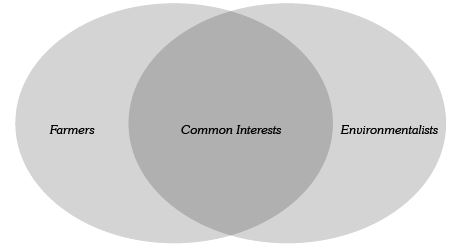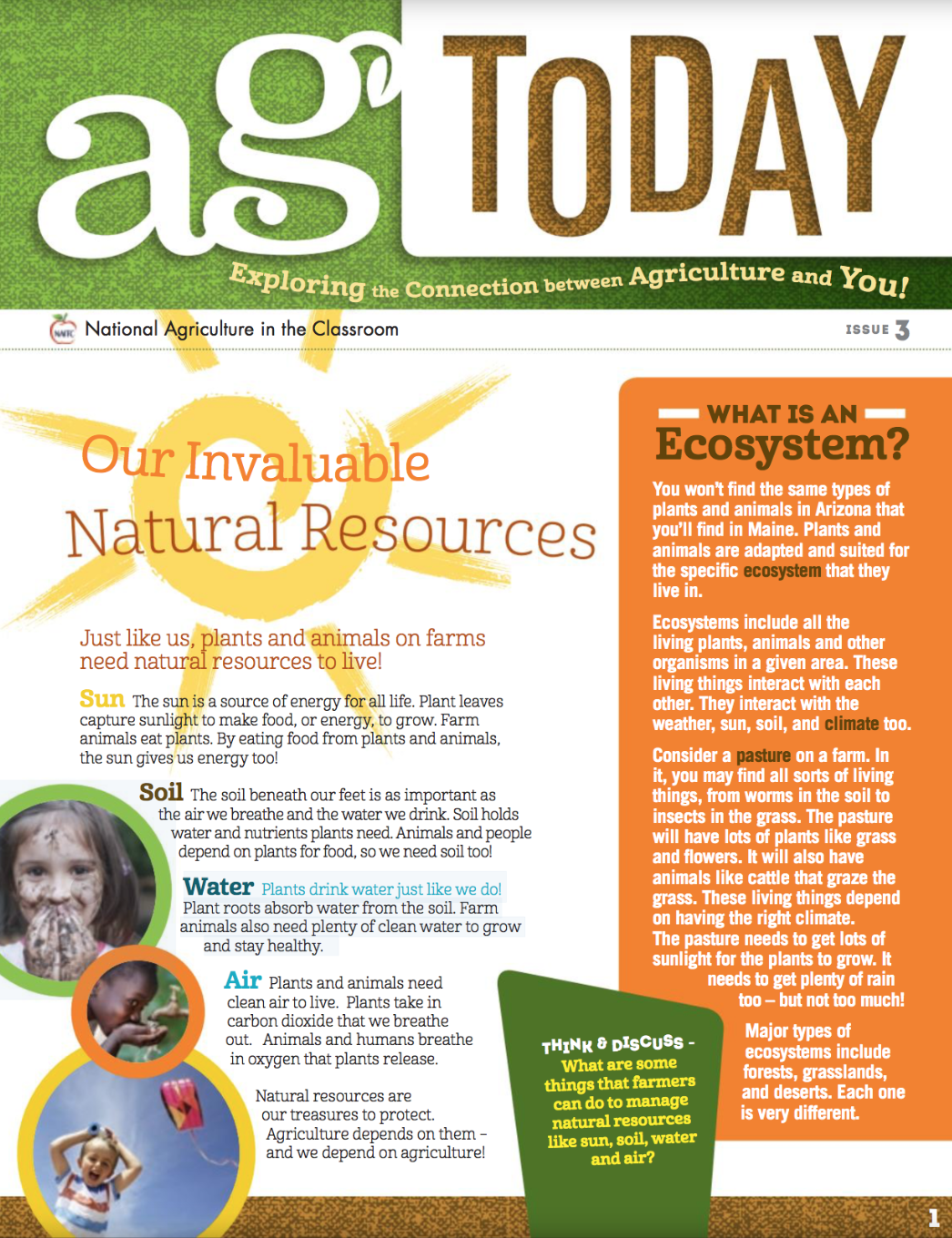Lesson Plan
Caring for the Land
Grade Level
Purpose
Students explain why people have different opinions regarding soil management and identify cause and effect relationships relating to agriculture and the environment. Grades 3-5
Estimated Time
Vocabulary
chemical (inorganic) fertilizers: synthetic materials that are added to the soil to provide nutrients—including nitrogen, phosphorus, and potassium—necessary to sustain plant growth
contaminate: to make something dirty or impure by accidentally or purposely adding something harmful
crop rotation: the successive planting of different crops in the same field over a period of years to maintain or improve soil quality and reduce pest problems
decompose: to decay or break down into smaller pieces
environmental activist: a person who works to protect the natural world through direct, vigorous action that is often focused on controversial issues
environmentalist: a person who works to protect the natural world from pollution and other threats
farmer: person who owns or manages a farm, cultivates land or crops, or raises animals
legume: a type of plant which has seeds contained in a pod such as a soybean, pea, or alfalfa plant
organism: any living thing made of cells
pesticide: a chemical that is used to control an organism living and growing where it is not wanted
Background Agricultural Connections
The land is the livelihood of farmers. Most people, farmers included, try to avoid practices that harm their way of life. When raising crops and livestock, farmers actively manage soil, water, plants, and animals. Farming is one of the closest working relationships that people have with the environment, and sometimes farming practices lead to environmental problems. Often, it takes years for the environmental impacts of human activity to become evident, and it can be complicated to identify and change environmentally damaging actions. Farmers work both to produce food and to care for the land that is their livelihood. There are many different strategies for accomplishing these goals.
Considering the history of environmental issues can put modern-day controversies into context. People began polluting long ago. Early settlers in the United States dumped their trash into rivers and streams without considering the harm it might do. Before gasoline-powered tractors began releasing exhaust fumes, work horses created pollution problems of their own. The average farm horse produces 35 pounds of solid waste and 2 gallons of liquid waste each day. Although horse manure can be an excellent fertilizer when spread across a field, large amounts in small areas can create high concentrations of nitrogen and bacteria that can contaminate the water supply.
Thousands of years ago, people began to farm because they found they could produce more food in a more reliable manner by growing crops than by hunting and gathering. Over the years, people discovered that some farming practices harmed the land. Cutting down trees, clearing vegetation, and allowing animals to overgraze left the topsoil unprotected and vulnerable to erosion by wind and water. Planting the same crop on the same field year after year used up all the soil’s nutrients, and the fields lost their ability to produce good crops.
Early farmers learned from their mistakes and developed better farming methods. They learned to farm on the contour and build terraces—ridges of soil built across the slope to slow water runoff. They learned to rotate their crops (crop rotation), moving them from one field to another to let the soil rest. They learned how to spread animal manure on their fields to restore organic matter and nutrients.
When European settlers came to the New World, they were dazzled by what seemed like endless resources—acres and acres of rich soil. Many farmers abandoned the methods their ancestors used to protect the land. When one field began to produce poor crops, the farmer would simply abandon it and move farther into the wilderness.
As more people moved in, more land was needed for farms. In the early twentieth century, farmers began plowing up the native grasses of the Southern Plains to plant wheat. They had no way of knowing that their hard work would be the first step leading to what would come to be known as the Dust Bowl. A severe drought dried up the exposed soil. With no grass roots to hold the sandy soil in place, it simply blew away with the strong summer winds.
Recognizing a problem is the first step toward solving it. Farmers didn’t know that plowing up large, flat tracts of land would cause the soil to blow away in the event of a drought. Once they saw what had happened, they did what farmers have been doing for thousands of years. They began thinking of different methods they could use that would protect the soil.
One method involved using chemicals on weeds instead of turning the soil with a plow. For many years, this method seemed like an excellent way to keep the soil in place while producing the food people needed. Then, scientists discovered that some chemicals were getting into the water supply and making birds, fish, animals, and people sick. Other chemicals have begun to lose their effectiveness as weeds develop resistance to them. Today, farmers and agricultural researchers are working on ways to solve food production problems while taking into consideration the growing world population, the state of food prices and economics, and the condition of environmental resources such as soil and water.
Engage
- Ask students to think about people they know who are farmers or environmentalists. Can farmers be environmentalists?
- Continue discussion on the topic to create interest and gauge students' prior knowledge using the following questions:
- Why would farmers be motivated to protect natural resources like soil and water?
- What motivates environmentalists to protect natural resources?
- What are some methods farmers use to protect soil and water quality?
Explore and Explain
- Begin the lesson by asking students to describe and define in their own terms the words: farmer, environmentalist, and environmental activist.
- Ask students if they have heard any news reports about conflicts between farmers and environmental activists (endangered species preservation, invasive species management, public land use, wetland preservation, etc.).
- Draw a Venn diagram on the whiteboard (see the example below), and ask students to list things about which farmers and environmental activists disagree and the things they have in common. For example, both care about the land, both need food to eat. Note: You may have to make very large circles.

- Share the background material and discuss problem/solution and cause/effect relationships.
- Divide your class into three groups, and hand out copies of one of the Caring for the Land activity sheets to each group.
- Ask students to read the situation described in the text carefully to identify the cause and effect, the problem and solution, and any alternatives and their effects. Ask each group to share what they discussed with the class.
- Discuss the following questions:
- Why do we need farmers? (food, clothes, shelter, other manufactured goods)
- Who should decide how to use the land?
- How should we decide how to use the land?
Elaborate
-
 Read Issue 3 of Ag Today titled Our Invaluable Natural Resources. This reader can be accessed digitally. It helps students understand how plants and animals raised on farms depend on natural resources to live, such as the sun, soil, water, and air to grow. Learn methods farmers use to protect and preserve these natural resources while still providing the food, fiber, and fuel we need to live.
Read Issue 3 of Ag Today titled Our Invaluable Natural Resources. This reader can be accessed digitally. It helps students understand how plants and animals raised on farms depend on natural resources to live, such as the sun, soil, water, and air to grow. Learn methods farmers use to protect and preserve these natural resources while still providing the food, fiber, and fuel we need to live. -
Play the My American Farm interactive game Thrive.
Evaluate
After conducting these activities, review and summarize the following key concepts:
- The land is the livelihood of farmers, and most farmers try to avoid practices that harm their way of life.
- People have differing opinions about environmental issues.
- Farms provide food, shelter, clothing, and other manufactured goods.
Acknowledgements
Lesson adapted from materials provided by Oklahoma Agriculture in the Classroom.
Recommended Companion Resources
- Ag Today
- America's Heartland: A Sea of Grass
- Black Blizzard
- Children of the Dust Bowl: The True Story of the School at Weedpatch Camp
- Dirt: Secrets in the Soil (DVD)
- Dirt: The Scoop on Soil
- Dust Bowl: CBS 1955 Documentary
- Erosion: How Hugh Bennett Saved America's Soil and Ended the Dust Bowl
- FDR's Fireside Chat: Dust Bowl
- Hugh Hammond Bennett: The Story of America's Private Lands Conservation video
- My American Farm
- Nutrients for Life eLessons
- Planet Zorcon
- Rocks and Soil
- Soil Health Education Resources
- Soil Science Videos
- Soil! Get the Inside Scoop
- Survival in the Storm
- The Great American Dust Bowl
- The Journal of C.J. Jackson, a Dust Bowl Migrant
- Third-Grader Explains Nature's Role in Providing Clean Water
- This Land Is Your Land
- Under Your Feet: Soil, Sand and Everything Underground
- You Wouldn't Want to Live Without Dirt!
Author
Organization
| We welcome your feedback! If you have a question about this lesson or would like to report a broken link, please send us an email. If you have used this lesson and are willing to share your experience, we will provide you with a coupon code for 10% off your next purchase at AgClassroomStore. |